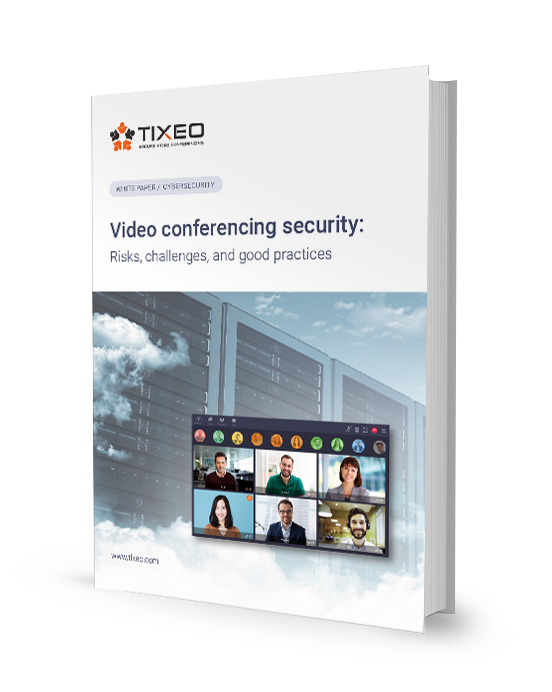Tixeo technology

Audio Stack
Why ?
Because audio communication is the most important. You can have UltraHD video, but if the sound is poor, the meeting is over.
Tixeo’s answer
Tixeo technology’s made the audio stack built around latest generation low latency audio codec (OPUS), and is linked to state-of-the-art denoising and echo-cancelling filters.
It simply delivers HD audio communication on any device and network.

Video Stack
Why ?
The biggest challenge of HD video conferencing is to provide the highest image quality using the least possible bandwidth.
Tixeo’s answer
A significant plus in Tixeo’s technology : the innovation of our unique SVCoD (Scalable Video Coding on Demand) technology takes the context of the meeting into account in the encoding strategy. Every participant simply sends the video layers needed in a meeting according to each of the other participants’ network capacity, equipment and display resolution.
We obtain the highest possible video quality and frame rate adapted to any device with up to 30% bandwidth saved.

Fast application sharing
Why ?
Being able to work together on a document during a meeting is very important. Some solutions simply send screen sharing the same way as video communication streams. The result is unreadable most of the time.
Tixeo’s answer
Our application and screen sharing technology allows sharing any kind of content on any network with high frame rate and perfect readability. It also allows working together by handing the control to a remote user.

MGE (Media Graph Engine)
Why ?
HD video conferencing and online collaboration requires the manipulation of lots of real-time streams (audio, video, desktop sharing…), transiting inside the software itself and on the network. On most systems, these manipulations introduce latency, audio- and video-quality loss and globally slow the communication.
Tixeo’s answer
The MGE is built over RIC and the communication framework. It allows easy hot-plugging of local or remote filters. It is a great technology to filter, process, chain and publish real-time streams.
With MGE, defining most advanced HD video conferencing strategies is effortless.

RIC (Remote Interface Call)
Why ?
Legacy video conferencing protocols (H.323, SIP, RTP) are very verbose, are a source of issues (due to bad interpretation and implementation of the protocol), and built on outdated protocols (older than the Internet).
Also, a message sent using these protocols can potentially be modified by malicious people and can’t be considered safe.
Tixeo’s answer
The RIC framework allows the use of any local or remote Tixeo’s technology in a software component just by calling an action on it or sending information to it, as a real-time high performance resource. By removing all concepts of protocol, bugs are avoided, and quality and security are increased.
It is the real-time full duplex “Web services” of Tixeo software components.

Communication framework
Why ?
Processing several HD video conferencing streams requires a framework capable of transferring simultaneously huge amounts of data to other software components locally or remotely.
Tixeo’s answer
This communication framework has been designed as the Internet of all Tixeo software components. It enables a fast and easy communication between local or remote components. It is designed for parallel processing and takes advantage of the great processing power offered by most recent multi-core CPUs.
It simply enables multi-point HD video conferencing on any device.

Proactive intelligente QoS (Quality of Service)
Why ?
Internet network quality has some unpredictable and important fluctuations. It is very important to take these variations into consideration because otherwise you can have sound cuts, video breakage, data loss and discontinued communication…
Tixeo’s answer
Tixeo’s technology in proactive QoS performs accurate and continuous monitoring of the network (bandwidth, latency, loss…) that enables an early detection of expected traffic congestions. Audio, video and data streams are immediately adapted to avoid the congestion. It also applies stream prioritization (audio/video first) to allow best communication conditions.
It easily guarantees the highest possible HD video conferencing quality on most networks.

Adaptive network layer with HTTPS tunneling
Why ?
Most video conferencing systems rely on protocols like H.323, SIP and UDP, which are commonly blocked by enterprise-grade network policies. To setup these kinds of systems, you will need a network guru for several days.
Tixeo’s answer
HTTPS tunneling: Tixeo’s technology merges all the audio, video and data streams in a unique communication stream, bundled in a HTTPS page. This does not require any technical intervention on your network (no ports to open, no changes on your security policies, seamlessly passes through firewalls and proxies).
You can invite whoever you want from anywhere and be assured to be communicating within seconds.

Learn more about Tixeo's security:
Security of videoconferencing
Need more information ?
Tixeo provides a secure video conferencing technology that is used by many organisations.
Find out what we can do for you.

